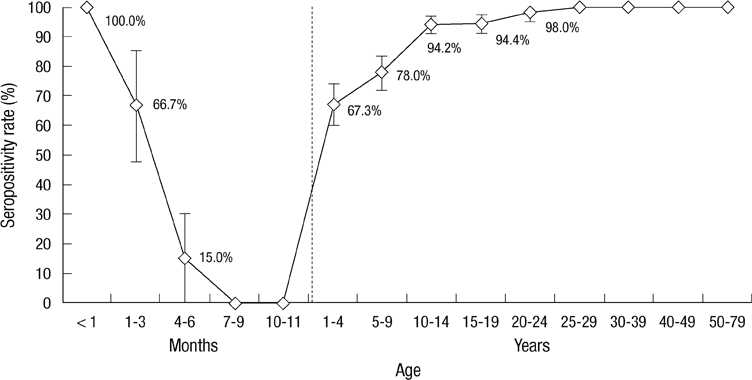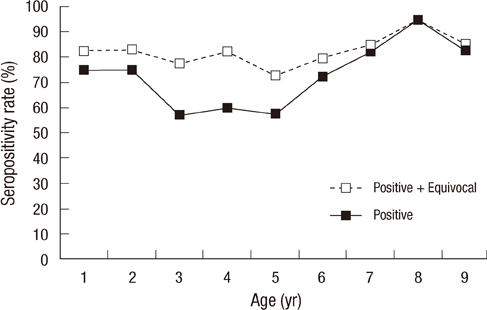J Korean Med Sci.
2013 Feb;28(2):195-199. 10.3346/jkms.2013.28.2.195.
Seroepidemiology of Varicella-Zoster Virus in Korea
- Affiliations
-
- 1Department of Pediatrics, School of Medicine, Ewha Womans University, and Center for Vaccine Evaluation and Study, Ewha Medical Research Institute, Seoul, Korea. kaykim@ewha.ac.kr
- KMID: 1429180
- DOI: http://doi.org/10.3346/jkms.2013.28.2.195
Abstract
- This study was designed to assess the immune status of the Korean population against varicella-zoster virus (VZV) through a seroepidemiologic study. Residual blood samples were collected from diagnostic laboratories throughout Korea. Samples were collected in October 2009 to March 2010 from persons 0-79 yr of age and were tested by ELISA (Enzygnost(R); Dade Behring, Schwalbach, Germany). Total seroprevalence in subjects 1-79 yr of age was 89.6%. Seroprevalence increased as age increased from 67.3% in subjects 1-4 yr of age to 94.2% in subjects 10-14 yr of age and in subjects over 20 yr of age seroprevalence ranged from 98.0% to 100%. In children under 1 yr of age, passive immunity waned after birth with none of the subjects having antibodies from 7 months of age and over. Among subjects 1-79 yr of age, susceptible subjects to VZV were mainly under 20 yr of age. These results provide information in understanding the dynamics of varicella disease in Korea, which is important in building up strategies for disease control.
MeSH Terms
-
Adolescent
Adult
Aged
Antibodies, Viral/analysis
Chickenpox/*epidemiology
Child
Child, Preschool
Enzyme-Linked Immunosorbent Assay
Female
Herpes Zoster/*epidemiology
Herpesvirus 3, Human/immunology/*isolation & purification
Humans
Infant
Male
Middle Aged
Republic of Korea/epidemiology
Seroepidemiologic Studies
Young Adult
Antibodies, Viral
Figure
Cited by 2 articles
-
Implementation of Hospital Policy for Healthcare Workers and Patients Exposed to Varicella-Zoster Virus
Si-Hyun Kim, Sun Hee Park, Su-Mi Choi, Dong-Gun Lee
J Korean Med Sci. 2018;33(36):. doi: 10.3346/jkms.2018.33.e252.Control and Prevention of Varicella in Healthcare Settings
Sun Young Cho
Korean J Healthc Assoc Infect Control Prev. 2021;26(2):83-88. doi: 10.14192/kjicp.2021.26.2.83.
Reference
-
1. Simpson RE. Infectiousness of communicable diseases in the household (measles, chickenpox, and mumps). Lancet. 1952. 2:549–554.2. Choo PW, Donahue JG, Manson JE, Platt R. The epidemiology of varicella and its complications. J Infect Dis. 1995. 172:706–712.3. Takahashi M, Otsuka T, Okuno Y, Asano Y, Yazaki T. Live vaccine used to prevent the spread of varicella in children in hospital. Lancet. 1974. 2:1288–1290.4. Marin M, Güris D, Chaves SS, Schmid S, Seward JF. Advisory Committee on Immunization Practices, Centers for Disease Control and Prevention (CDC). Prevention of varicella: recommendations of the Advisory Committee on Immunization Practices (ACIP). MMWR Recomm Rep. 2007. 56:1–40.5. United Nations Children's Fund & World Health Organization. Immunization summary: the 2011 edition. 2011. Geneva:6. Michalik DE, Steinberg SP, Larussa PS, Edwards KM, Wright PF, Arvin AM, Gans HA, Gershon AA. Primary vaccine failure after 1 dose of varicella vaccine in healthy children. J Infect Dis. 2008. 197:944–949.7. Chaves SS, Gargiullo P, Zhang JX, Civen R, Guris D, Mascola L, Seward JF. Loss of vaccine-induced immunity to varicella over time. N Engl J Med. 2007. 356:1121–1129.8. Choi WS, Noh JY, Huh JY, Jo YM, Lee J, Song JY, Kim WJ, Cheong HJ. Seroprevalence of varicella-zoster virus in Korea. J Med Virol. 2010. 82:2123–2126.9. Kim YH, Hwang JY, Lee KM, Choi JH, Lee TY, Choi JS, Park HS. Seroepidemiologic survey of varicella-zoster virus in Korean adults using glycoprotein enzyme immuno assay and fluorescent antibody to membrane antigen test. Ann Dermatol. 2011. 23:39–43.10. Gabutti G, Rota MC, Guido M, De Donno A, Bella A, Ciofi degli Atti ML, Crovari P. Seroepidemiology Group. The epidemiology of varicella zoster virus infection in Italy. BMC Public Health. 2008. 8:372.11. Gidding HF, MacIntyre CR, Burgess MA, Gilbert GL. The seroepidemiology and transmission dynamics of varicella in Australia. Epidemiol Infect. 2003. 131:1085–1089.12. Kilgore PE, Kruszon-Moran D, Seward JF, Jumaan A, Van Loon FP, Forghani B, McQuillan GM, Wharton M, Fehrs LJ, Cossen CK, et al. Varicella in Americans from NHANES III: implications for control through routine immunization. J Med Virol. 2003. 70:S111–S118.13. Sauerbrei A, Wutzler P. Serological detection of varicella-zoster virus-specific immunoglobulin G by an enzyme-linked immunosorbent assay using glycoprotein antigen. J Clin Microbiol. 2006. 44:3094–3097.14. De Ory F, Echevarria JM, Kafatos G, Anastassopoulou C, Andrews N, Backhouse J, Berbers G, Bruckova B, Cohen DI, de Melker H, et al. European seroepidemiology network 2: standardisation of assays for seroepidemiology of varicella zoster virus. J Clin Virol. 2006. 36:111–118.15. Park B, Lee YK, Cho LY, Go UY, Yang JJ, Ma SH, Choi BY, Lee MS, Lee JS, Choi EH, et al. Estimation of nationwide vaccination coverage and comparison of interview and telephone survey methodology for estimating vaccination status. J Korean Med Sci. 2011. 26:711–719.16. Varicella vaccines: WHO position paper. Wkly Epidemiol Rec. 1998. 73:241–248.17. Centers for Disease Control and Prevention (CDC). Outbreak of varicella among vaccinated children: Michigan, 2003. MMWR Morb Mortal Wkly Rep. 2004. 53:389–392.18. Lopez AS, Guris D, Zimmerman L, Gladden L, Moore T, Haselow DT, Loparev VN, Schmid DS, Jumaan AO, Snow SL. One dose of varicella vaccine does not prevent school outbreaks: is it time for a second dose? Pediatrics. 2006. 117:e1070–e1077.19. World Health Organization (WHO). WHO Vaccine Preventable Diseases Monitoring System. accessed on 13 May 2011. Available at http://apps.who.int/immunization_monitoring/en/globalsummary/ScheduleSelect.cfm.
- Full Text Links
- Actions
-
Cited
- CITED
-
- Close
- Share
- Similar articles
-
- Herpes zoster complicated by deep vein thrombosis : a case report
- Two cases of varicella zoster meningitis in immunocompetent children
- Association of Herpes Zoster and Lymphosarcoma: Report of one Case
- A clinical study on varicella zoster virus infection and treatment in children with malignant lymphoproliferative disease
- Clinical Significance of Serum Varicella Zoster Virus Immunoglobulin M and G in Varicella and Herpes Zoster



